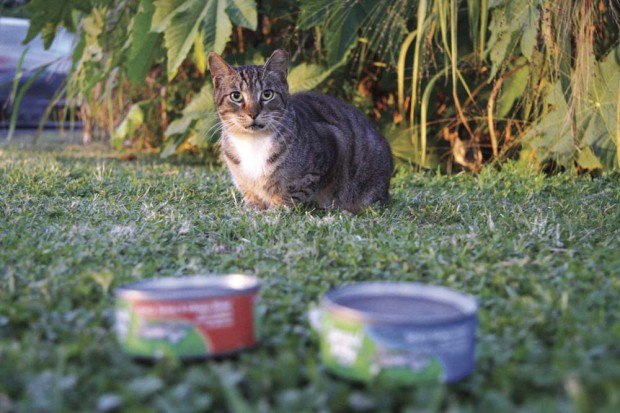NAWILIWILI — Which is preferable, a dead tomcat or a neutered feline roaming the island?
Last week the Kaua‘i County Council’s Committee of the Whole voted 4-3 recommending approval of a resolution supporting Trap, Neuter and Release as a component of a humane approach to controlling the Garden Isle’s feral cat population.
This week the council stepped back and unanimously voted to just receive the resolution. In other words, the proposed policy statement was shelved without an official endorsement either way.
The council’s move makes Kaua‘i’s endangered birds no safer against what Maka‘ala Ka‘aumoana, vice chair of Hui Ho‘omalu i ka ‘Aina, said may be “the most widespread alien predator in the world.”
The inaction does give assurance that the council did not make a decision that could potentially be construed as encouraging the killing or harming of a protected species.
“I’d like to remind this council that the County of Kaua‘i is on probation with the federal government,” said County Attorney Al Castillo, explaining that the county is applying for a federal permit for incidental take of endangered seabirds.
Castillo said such a permit could cost the county anywhere between $500,000 and $1 million, but if the county shows “serious deference” to the Endangered Species Act, the cost of the permit could be much lower.
The probationary period started in September and will last 30 months, according to the county attorney.
“We can do trap and neuter, but to do TNR would be actively releasing a predator,” Castillo said.
The county is in the process of completing a habitat conservation plan, he said.
“Part of the terms of the probation is, we have to complete a monitoring plan,” Castillo said. “This monitoring plan includes the county’s plan for predator control.”
Castillo said that just to see a shearwater flying around a county stadium light is considered a take.
“A take is a violation,” he said, adding that a fine could be as high as $10,000. “And this is just one fly-around. … That’s how seriously we should pay attention to the Endangered Species Act.”
‘Primary predators’
Biologist Don Heacock, from the Aquatic Resources Division of the state Department of Land and Natural Resources, said the state Constitution states that Hawai‘i and all of its political sub-divisions, including the counties, are to protect all of the state’s natural resources, defined as naturally occurring plants and animals.
“Feral cats are not only unnatural, they are also invasive,” he said. “We’ve known for over 60 years that they are the primary predators of what are now endangered Hawaiian water birds. Things like the alai ula, the Hawaiian stilt and the Koloa ducks are literally sitting ducks, no pun intended, to feral cats, because they nest on the ground.”
Councilman Tim Bynum asked earlier in the meeting what is the difference between releasing spayed or neutered feral cats back into a shopping center and releasing spayed or neutered domesticated cats in a neighborhood in Hanalei or Ha‘ena. “That’s what we do, right?”
Heacock said when a “very nice lady” doesn’t show up to feed the cats in a feral colony she manages by Lihu‘e Post Office, the cats may go hunt in Nawiliwili Stream, 200 yards away and home to Hawaiian water birds.
“There’s a big difference,” said Heacock, noting that he hopes cat owners are attempting to keep their cats in their backyards and are feeding their pets every day.
“What we should do, and what is the most humane thing to do, is to trap and euthanize feral cats; they cannot be tamed,” said Heacock.
The biologist said he spoke that morning with three veterinarians who all told him that spayed/neutered feral cats are released into “very crowded conditions” and that diseases will spread very quickly, killing them slowly and painfully.
In addition, non-neutered/spayed cats join the colonies that are being fed, increasing the colony’s population.
Working toward
a solution
Councilwoman JoAnn Yukimura said the council is “ending the resolution but not ending the problem-solving,” adding that the council will be putting together a group of stakeholders.
Councilwoman Nadine Nakamura thanked Councilman Mel Rapozo for introducing the resolution to raise awareness on the council and in the community.
“There seems to be some commitment to take a leadership role, because we know this problem is not going away,” she said. “We need both the county and the administration to say ‘We need to work together to make sure this habitat conservation plan is just something not in writing but it’s something we’re working toward.’”
Go to www.kauai.gov for more information.
• Léo Azambuja, staff writer, can be reached at 245-3681 (ext. 252) or lazambuja@ thegardenisland.com.




